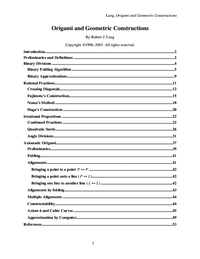Autor "Evan Hahn"
Se han encontrado 1 Coincidencias
Origami and geometrics constructions
geometría y origami
132 Visitas | 166 Descargas | 2013-10-17 15:14:31 | javierd
The classical rules of compass-and-straightedge allow a single compass to strike arcs and transfer distances, and a single unmarked straightedge to draw straight lines; the two may not be used in combination (for example, holding the compass against the straightedge to effectively mark the latter). However, there are many variations on the general theme of geometric constructions that include use of marked rules and tools other than compasses for the construction of geometric figures. One of the more interesting variations is the use of a folded sheet of paper for geometric construction. Like compass-and-straightedge constructions, folded-paper constructions are both academically interesting and practically useful—particularly within origami, the art of folding uncut sheets of paper into interesting and beautiful shapes. Modern origami design has shown that it is possible to fold shapes of unbelievable complexity, realism, and beauty from a single uncut square. Origami figures posses an aesthetic beauty that appeals to both the mathematician and the layman. Part of their appeal is the simplicity of the concept: from the simplest of beginnings springs an object of depth, subtlety, and complexity that often can be constructed by a precisely defined sequence of folding steps. However, many origami designs—even quite simple ones—require that one create the initial folds at particular locations on the square: dividing it into thirds or twelfths, for example. While one could always measure and mark these points, there is an aesthetic appeal to creating these key points, known as reference points, purely by folding.
Contribuir
Usted puede contribuir con Libros UCLV, es importante para nosotros su aporte..
Contribuir